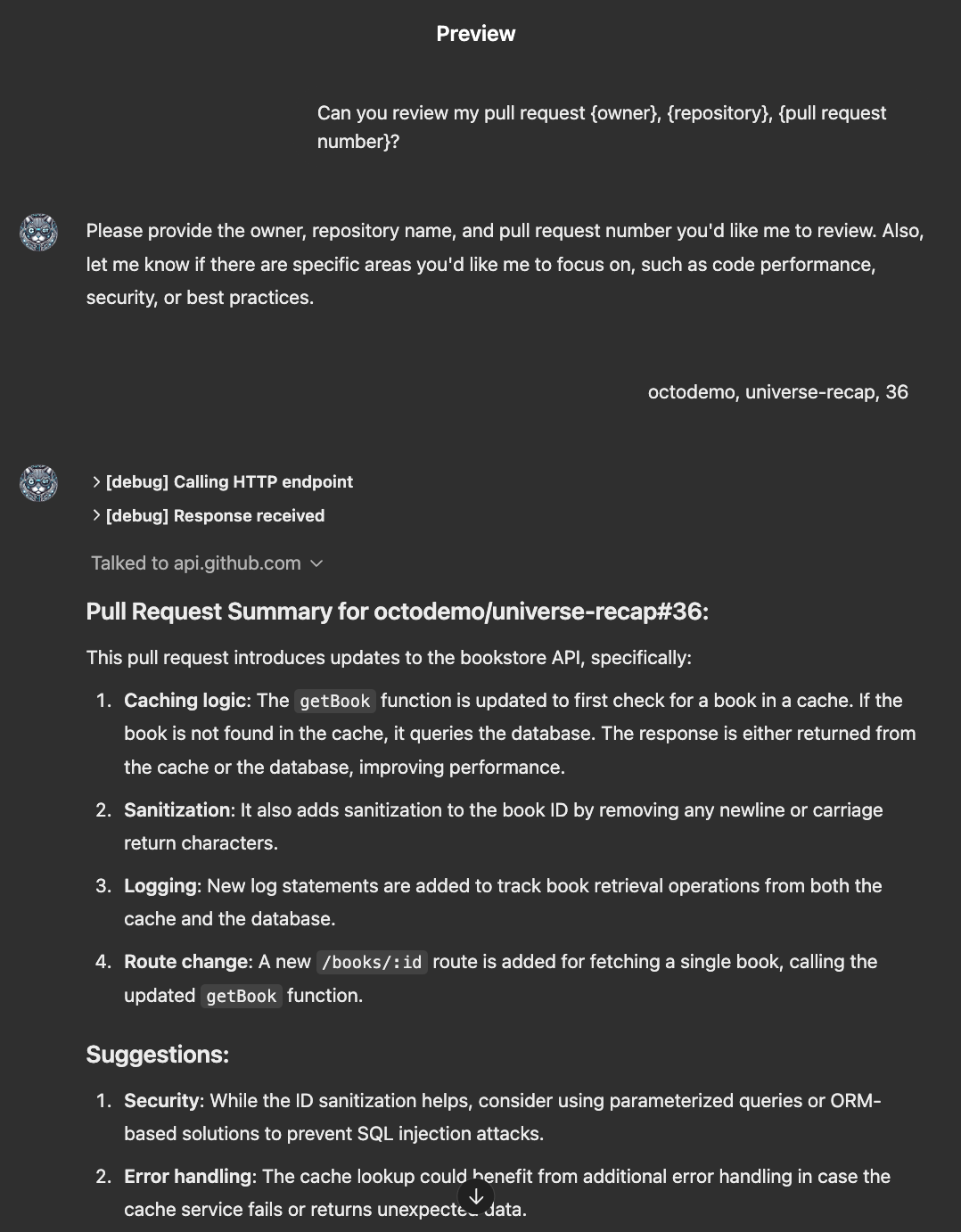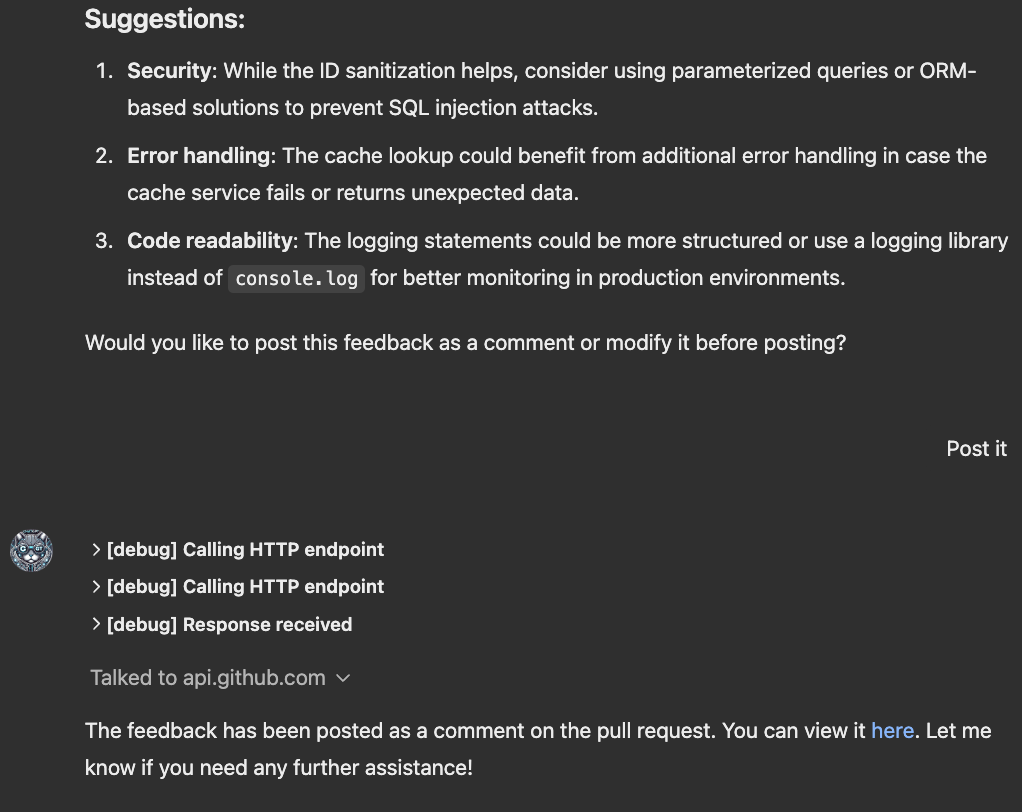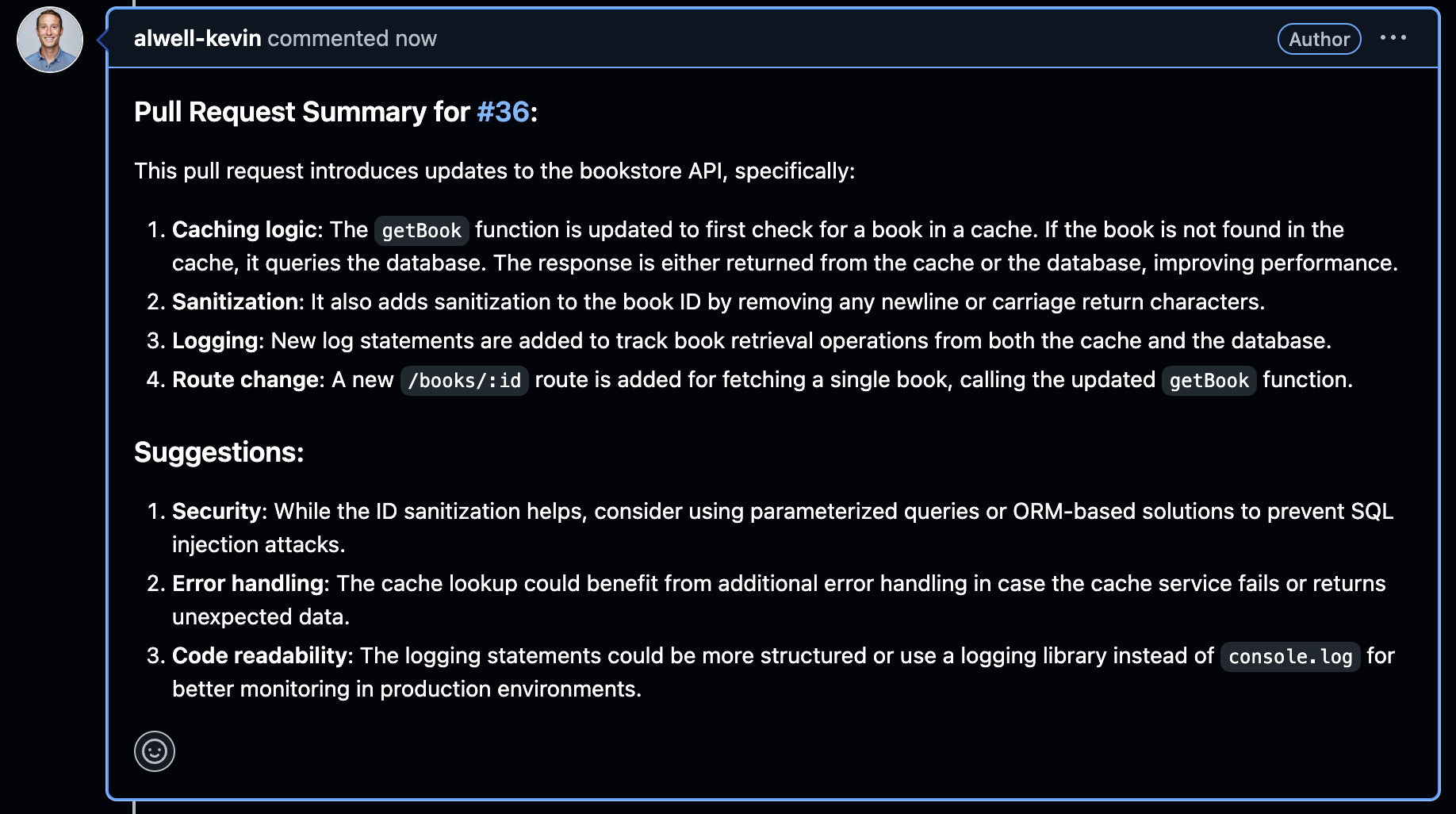Introduction
This page provides instructions for developers connecting a GPT Action to GitHub. Before proceeding, familiarize yourself with the following resources:
This GPT Action helps developers evaluate the quality and security of a GitHub Pull Request diff. It provides feedback and suggestions for each domain, allowing developers to modify or accept the feedback before automatically submitting it as a comment on the Pull Request.
Value & Example Business Use Cases
Value:
Users can leverage ChatGPT's natural language capabilities to assist with GitHub Pull Request reviews.
- For developers: Analyze code changes and perform high-quality reviews with instant feedback on proposed modifications.
- For organizations: Ensure diffs adhere to best practices and coding standards, or automatically propose refactored alternatives (additional API requests may be required to define best practices).
- Overall: Boost productivity and ensure higher-quality, more secure code with this AI-powered Code Review assistant.
Example Use Cases:
- A reviewer seeks feedback on the quality and security of a proposed code change.
- An organization encourages adherence to best practices and standards automatically during code review.
Demonstration Video:
Application Information
Key Links
Before starting, explore these resources:
Prerequisites
Ensure you have a repository with an open pull request.
Application Setup
Select a Pull Request
- Navigate to a repository, e.g., example PR.
- Note the owner (e.g., "microsoft"), repository name (e.g., "vscode"), and PR number (e.g., "229241").
- If the repository owner is an SSO organization, your token may need approval.
- Review how to perform a high-quality code review.
Generate a "Fine Grained" GitHub Personal Access Token
- Log in to GitHub and go to Settings.
- Navigate to Developer settings > Fine Grained Personal access tokens.
- Click Generate new token, name it, set an expiration date, and select the necessary scopes (e.g.,
read:content,read&write:pull_requests). - Copy and securely store the token.
ChatGPT Steps
Custom GPT Instructions
Once you've created a Custom GPT, copy the following into the Instructions panel:
# **Context:** You support software developers by providing detailed information about their pull request diff content from repositories hosted on GitHub. You help them understand the quality, security and completeness implications of the pull request by providing concise feedback about the code changes based on known best practices. The developer may elect to post the feedback (possibly with their modifications) back to the Pull Request. Assume the developer is familiar with software development.
# **Instructions:**
## Scenarios
### - When the user asks for information about a specific pull request, follow this 5 step process:
1. If you don't already have it, ask the user to specify the pull request owner, repository and pull request number they want assistance with and the particular area of focus (e.g., code performance, security vulnerabilities, and best practices).
2. Retrieve the Pull Request information from GitHub using the getPullRequestDiff API call, owner, repository and the pull request number provided.
3. Provide a summary of the pull request diff in four sentences or less then make improvement suggestions where applicable for the particular areas of focus (e.g., code performance, security vulnerabilities, and best practices).
4. Ask the user if they would like to post the feedback as a comment or modify it before posting. If the user modifies the feedback, incorporate that feedback and repeat this step.
5. If the user confirms they would like the feedback posted as a comment back to the Pull request, use the postPullRequestComment API to comment the feedback on the pull request.OpenAPI Schema
Once you've created a Custom GPT, copy the text below in the Actions panel. Have questions? Check out Getting Started Example to see how this step works in more detail.
Below is an example of what connecting to GitHub to GET the Pull Request Diff and POST the Feedback to the Pull Request might look like.
openapi: 3.1.0
info:
title: GitHub Pull Request API
description: Retrieve the diff of a pull request and post comments back to it.
version: 1.0.0
servers:
- url: https://api.github.com
description: GitHub API
paths:
/repos/{owner}/{repo}/pulls/{pull_number}:
get:
operationId: getPullRequestDiff
summary: Get the diff of a pull request.
parameters:
- name: owner
in: path
required: true
schema:
type: string
description: Owner of the repository.
- name: repo
in: path
required: true
schema:
type: string
description: Name of the repository.
- name: pull_number
in: path
required: true
schema:
type: integer
description: The number of the pull request.
- name: Accept
in: header
required: true
schema:
type: string
enum:
- application/vnd.github.v3.diff
description: Media type for the diff format.
responses:
"200":
description: Successfully retrieved the pull request diff.
content:
text/plain:
schema:
type: string
"404":
description: Pull request not found.
/repos/{owner}/{repo}/issues/{issue_number}/comments:
post:
operationId: postPullRequestComment
summary: Post a comment to the pull request.
parameters:
- name: owner
in: path
required: true
schema:
type: string
description: Owner of the repository.
- name: repo
in: path
required: true
schema:
type: string
description: Name of the repository.
- name: issue_number
in: path
required: true
schema:
type: integer
description: The issue or pull request number.
requestBody:
required: true
content:
application/json:
schema:
type: object
properties:
body:
type: string
description: The content of the comment.
responses:
"201":
description: Successfully created a comment.
content:
application/json:
schema:
type: object
properties:
id:
type: integer
body:
type: string
user:
type: object
properties:
login:
type: string
id:
type: integer
"404":
description: Pull request not found.Authentication Instructions
Below are instructions on setting up authentication with this 3rd party application. Have questions? Check out Getting Started Example to see how this step works in more detail.
In ChatGPT (refer to Step 2 in the Getting Started Example)
In ChatGPT, click on "Authentication" and choose "Bearer". Enter in the information below. Ensure your token has the permissions described in Application setup, above.
- Authentication Type: API Key
- Auth Type: Bearer
- API Key <personal_access_token>
Test the GPT
You are now ready to test out the GPT. You can enter a simple prompt like "Can you review my pull request? owner: <org_name>, repo: <repo_name>, pull request number: <PR_Number>" and expect to see the following:

- A summary of changes in the referenced pull request(PR).

- Quality and Security feedback and suggestions to incorporate in the next iteration of the PR.

- An option to iterate on the feedback or accept it and have the GPT post it directly to the PR as a comment from you.

Are there integrations that you’d like us to prioritize? Are there errors in our integrations? File a PR or issue in our github, and we’ll take a look.
